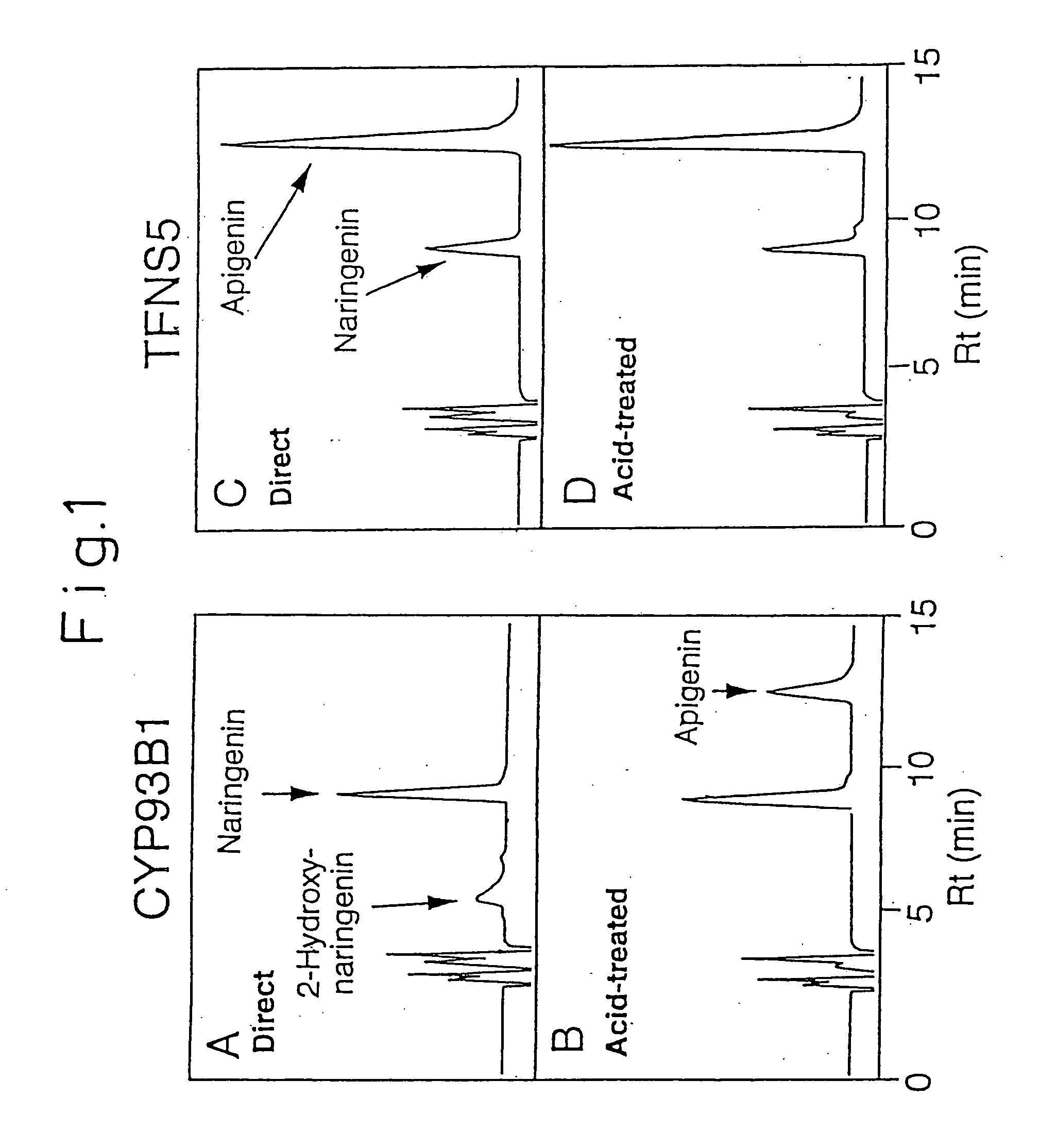DNAs coding for flavone synthases, methods of using flavone synthase DNAs, and plants, flowers, and vectors containing flavone synthase DNAs
a technology of flavone synthase and coding gene, which is applied in the direction of peptides, plant/algae/fungi/lichens ingredients, enzymology, etc., can solve the problems of inability to control the biosynthesis of flavones, no genes have been identified for enzymes with activity, and no techniques have been reported for controlling their biosynthesis. , to achieve the effect of improving the antibacterial properties of plants, improving the ability of legumes
- Summary
- Abstract
- Description
- Claims
- Application Information
AI Technical Summary
Benefits of technology
Problems solved by technology
Method used
Image
Examples
example 1
Cloning of Snapdragon Flavone Synthase II Gene
[0053] RNA was extracted from about 5 g of young buds of a Yellow Butterfly snapdragon (commercial name by Sakata-no-Tane, KK.), and polyA+ RNA was obtained by an Oligotex. This polyA+ RNA was used as a template to prepare a cDNA library using a Lambda ZAPII cDNA Library Synthesis Kit (Stratagene) by the method recommended by Stratagene (Stratagene Instruction Manual, Revision #065001). The cDNA library was screened using the full length cDNA CYP93B1 as the probe. The screening and detection of positive clones were carried out using a DIG-DNA-labeling and detection kit (Boehringer) based on the method recommended by the same company, under a low stringent condition.
[0054] Specifically, a hybridization buffer (5×SSC, 30% formamide, 50 mM sodium phosphate buffer (pH 7.0), 1% SDS, 2% blocking reagent (Boehringer), 0.1% lauroylsarcosine, 80 μg / ml salmon sperm DNA) was used for prehybridization at 42° C. for 2 hours, after which the DIG-lab...
example 2
Cloning of Torenia Flavone Synthase II Gene
[0056] RNA was extracted from approximately 2 g of buds of a torenia variety (variety name: Sunrenive, Variety Registration Application No.: 7433 according to the Seeds and Seedlings Law, by Suntory Ltd.) and the polyA+ RNA was obtained with an Oligotex. The polyA+ RNA was used as a template to prepare a cDNA library using a Lambda ZAPII cDNA Library Synthesis Kit (Stratagene) by the method recommended by Stratagene as mentioned in Example 1. The cDNA library was screened using a mixture of the aforementioned CYP93B1 cDNA and ANFNS1 cDNA as the probes. The screening and detection of positive clones were carried out under the low stringent conditions as described in Example 1.
[0057] One positive clone was obtained, and was designated as TFNS5. Upon determining the full nucleotide sequence of TFNS5 cDNA, it was found that the protein encoded by TFNS5 cDNA exhibited 52% identity on the amino acid level with flavanone-2-hydroxylase encoded by...
example 3
Expression of Torenia Flavone Synthase II Gene in Yeast
[0058] The following experiment was conducted in order to detect the enzyme activity of the protein encoded by TFNS5, the torenia cDNA obtained in Example 2. Parts of the outside of the translated region of the gene were modified to introduce restriction enzyme sites therein to prepare a sense primer (5′-AAATAGGATCCAAGCatgGACACAGTCTTAA-3′; underline=BamHI site; lowercase letters: initiation codon) (SEQ.ID. No.5) and an antisense primer (5′-CCCTTCTAGAtcaAGCACCCGATATTGTGGCCGGG-3′; underline=XbaI site; lowercase letters: termination codon) (SEQ.ID. No.6) were used with KOD polymerase (Toyobo) for PCR reaction. The PCR conditions were 98° C. for one minute, 20 cycles of (98° C. for 15 seconds, 55° C. for 10 seconds, 74° C. for 30 seconds), followed by 74° C. for 10 minutes.
[0059] After introducing the resultant PCR product into the EcoRV site of pBluescriptII SK(−) (Stratagene), it was digested with restriction enzymes BamHI and X...
PUM
 Login to View More
Login to View More Abstract
Description
Claims
Application Information
 Login to View More
Login to View More - R&D
- Intellectual Property
- Life Sciences
- Materials
- Tech Scout
- Unparalleled Data Quality
- Higher Quality Content
- 60% Fewer Hallucinations
Browse by: Latest US Patents, China's latest patents, Technical Efficacy Thesaurus, Application Domain, Technology Topic, Popular Technical Reports.
© 2025 PatSnap. All rights reserved.Legal|Privacy policy|Modern Slavery Act Transparency Statement|Sitemap|About US| Contact US: help@patsnap.com

